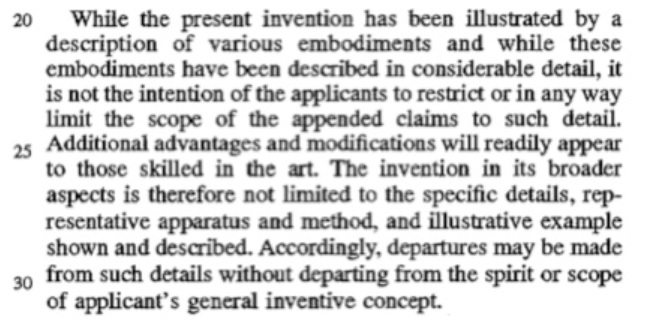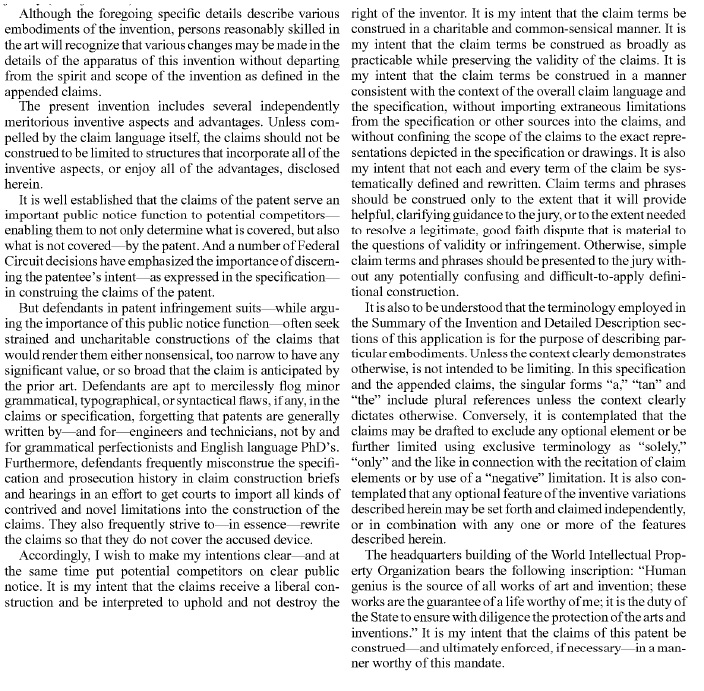There are two types of incorporation by reference in patent documents. The first type arises automatically from a priority claim to a prior application. If priority is claimed as of the filing date, then pursuant to 37 C.F.R. §1.57(a) the application is considered to have incorporated by reference any inadvertently omitted material from the parent application, allowing the applicant to amend the current application to include the inadvertently omitted material. The second type of incorporation by reference is a purposeful incorporation by reference pursuant to 37 C.F.R. §1.57(b) of material to avoid having to reproduce the material in the specification.
To purposefully incorporate material into a patent specification, the specification must express a clear intent to incorporate by reference by using the root words “incorporat(e)” and “reference” (e.g., “incorporate by reference”), and clearly identify the referenced patent, application, or publication. Even “essential material” may be incorporated by reference (37 C.F.R. §1.57(c)), but only by reference to a U.S. patent or U.S. patent application publication, and not other types of patents or publications. The referenced U.S. patent or patent application must not itself incorporate such essential material by reference. “Essential material” is material that is necessary to: (1) provide a written description or enabling disclosure under 35 U.S.C. §112(a); (2) particularly point out and distinctly claim the invention as required by 35 U.S.C. §112(b); or (3) describe the structure, material, or acts that correspond to a claimed means or step for performing a specified function as required by 35 U.S.C. §112(f).
An incorporation by reference should specifically define the material being incorporated by reference, and more importantly define what is not being incorporated by reference. Most applicants call for the complete incorporation by reference: “incorporated by reference for all that it contains” (U.S. Patent No. 7541813); “incorporated by reference for all purposes as if fully set forth herein” (U.S. Patent No. 7372731); “the entireties of which (including all references incorporated by reference therein) are incorporated by reference herein for all purposes” (U.S. Patent No. 8281670. Some applicants include catch-all incorporation of any document referred to:
All publications, patents and patent applications referred to herein are incorporated by reference in their entirety to the same extent as if each individual publication, patent or patent application was specifically and individually indicated to be incorporated by reference in its entirety.
U.S. Application 20070119058, or:
All references cited herein are incorporated by reference to the maximum extent allowable by law.
US20120288335. While it is tempting to simply incorporate the material “in its entirety” (how can more disclosure ever be a bad thing?), this can have unintended consequences for example where the incorporated material includes express definitions or disclaimers. Some applications include boiler plate to address this situation:
Any incorporation by reference of documents above is limited such that no subject matter is incorporated that is contrary to the explicit disclosure herein. Any incorporation by reference of documents above is further limited such that no claims included in the documents are incorporated by reference herein. Any incorporation by reference of documents above is yet further limited such that any definitions provided in the documents are not incorporated by reference herein unless expressly included herein.
U.S. Patent No. 8573045. This language might be improved by also excluding any disclaimers. In X2Y Attenuators, LLC, v. ITC, 757 F.3d 1358 (Fed. Cir. 2014), the Federal Circuit held that disclaimers were incorporated into the patent in suit through incorporation by reference.
Other attempts at avoiding unintended results from incorporation address inconsistent usage:
In the event of inconsistent usages between this document and those documents so incorporated by reference, the usage in the incorporated reference(s) should be considered supplementary to that of this document; for irreconcilable inconsistencies, the usage in this document controls.
U.S. Patent No. 8798340. And:
Any information in any material (e.g., a United States patent, United States patent application, book, article, etc.) that has been incorporated by reference herein, is only incorporated by reference to the extent that no conflict exists between such information and the other statements and drawings set forth herein. In the event of such conflict, including a conflict that would render invalid any claim herein or seeking priority hereto, then any such conflicting information in such incorporated by reference material is specifically not incorporated by reference herein.
U.S. Patent No. 7398012. A more complete treatment of incorporation by reference might be:
All patent applications, patents, and printed publications cited herein are incorporated herein by reference in the entireties, except for any definitions, subject matter disclaimers or disavowals, and except to the extent that the incorporated material is inconsistent with the express disclosure herein, in which case the language in this disclosure controls.
As an alternative to a boilerplate disclaimer, the incorporation language might be tailored to the situation:
U.S. Patent No. XXXXXXX, the entire disclosure of which, except for any definitions, disclaimers, disavowals, and inconsistencies, is incorporated herein by reference.
unless, of course, the definitions or disclaimers are important.
In addition to the inadvertent incorporation of potentially harmful material, an additional concern is the effect of incorporation by reference upon subsequent foreign filings. If these countries do not recognize incorporation by reference to the same extent as the United States does, the disclosure may be insufficient.
Incorporation by reference is a great tool for patent drafters, but as with everything in a patent specification, must be used thoughtfully.


